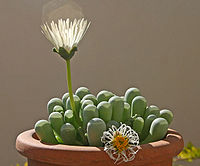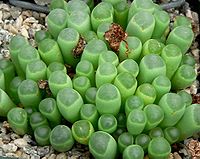| This article needs additional citations for verification. Please help improve this article by adding citations to reliable sources. Unsourced material may be challenged and removed. Find sources: "Fenestraria" – news · newspapers · books · scholar · JSTOR (September 2014) (Learn how and when to remove this message) |
| Fenestraria | |
|---|---|

| |
| Fenestraria rhopalophylla | |
| Scientific classification | |
| Kingdom: | Plantae |
| Clade: | Tracheophytes |
| Clade: | Angiosperms |
| Clade: | Eudicots |
| Order: | Caryophyllales |
| Family: | Aizoaceae |
| Subfamily: | Ruschioideae |
| Tribe: | Ruschieae |
| Genus: | Fenestraria N.E.Br. |
| Species: | F. rhopalophylla |
| Binomial name | |
| Fenestraria rhopalophylla (Schltr. & Diels) N.E.Br. | |
| Synonyms | |
|
Fenestraria aurantiaca | |
Fenestraria (known as babies' toes) is a (possibly monotypic) genus of succulent plants in the family Aizoaceae, native to the Namaqualand in Namibia.
Description


The only species currently recognised in this genus is Fenestraria rhopalophylla. Each leaf has an epidermal window, a transparent window-like area, at its rounded tip, it is for these window-like structures that the genus is named (Latin: fenestra).
Fenestraria rhopalophylla appears very similar to Frithia pulchra, though the leaves are a slightly different shape and F. rhopalophylla has yellow flowers, compared to the pink flowers of F. pulchra.
Distribution and habitat
In the wild, the plant commonly grows under sand, except for the transparent tips, which allow light into the leaves for photosynthesis. The plant produces optical fibers made from crystalline oxalic acid which transmit light to subterranean photosynthetic sites.
Fenestraria rhopalophylla is native to Namaqualand in southern Africa and to Namibia. The plants generally grow in sandy or calciferous soils under low < 100 mm rainfall, that occurs in the winter.
Subspecies
- F. rhopalophylla subsp. rhopalophylla with white flowers in autumn
- F. rhopalophylla subsp. aurantiaca with yellow flowers
References
- USDA GRIN Taxonomy, retrieved 19 August 2016
- Featured plant: Fenestraria rhopalophylla subsp. aurantiaca, retrieved 25 August 2020
| Taxon identifiers | |
|---|---|
| Fenestraria | |
| Fenestraria rhopalophylla | |